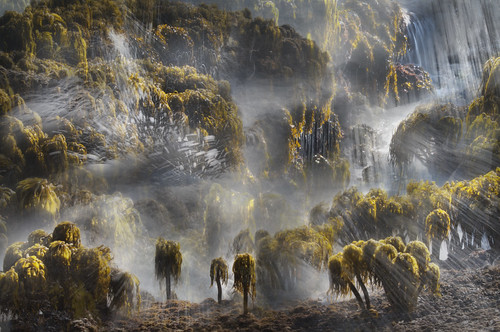
Sea Palm Forest, photo by Harold Davis. View this image larger.
Along the rugged northern California coast, on BLM land near the Point Arena Lighthouse, I stopped to photograph a bed of kelp as it was struck by surf in the intertidal zone. This form of kelp is Postelsia palmaeformis, commonly called the Sea Palm for reasons you can see. To get a sense of the scale, one of the Sea Palms in the foreground of the image was about one foot high.
I was alone on a rocky cliff with Nicky facing the pounding ocean; he was worried that I would be swept away and kept running up to higher ground.
The image is made from 45 stacked layers using the Photoshop Statistics program. With the camera on tripod, I exposed when I thought the wave action on the Sea Palm forest looked particularly good. Each exposure was in the 1/6 of a second to 1/20 of a second range with the lens stopped down to f/32 (it was near to sunset). This was slow enough to render moving water as somewhat blurred. As opposed to the star stacking paradigm, I did not use a timer, and I did not expose at fixed intervals—I fired the shutter whenever I thought the scene looked good. Essentially, this is compositing over time rather than over space—as far as I know a new way of looking at things other than star circles. As a technique, HDR accomplishes the same thing with exposure dynamic range, but not because it extends the time frame of the resulting composite image.
After the Statistics composite stack was created, I layered in a few touches from individual exposures to finish the image.
My inspiration for this attempt was the classic (1968) Wynn Bullock photo of Sea Palms in the surf—long one of my favorite images.
timetre
30 Aug 2010Very impressive !
Pingback: Sea Palms | Photoblog 2.0
Pingback: Within the Web